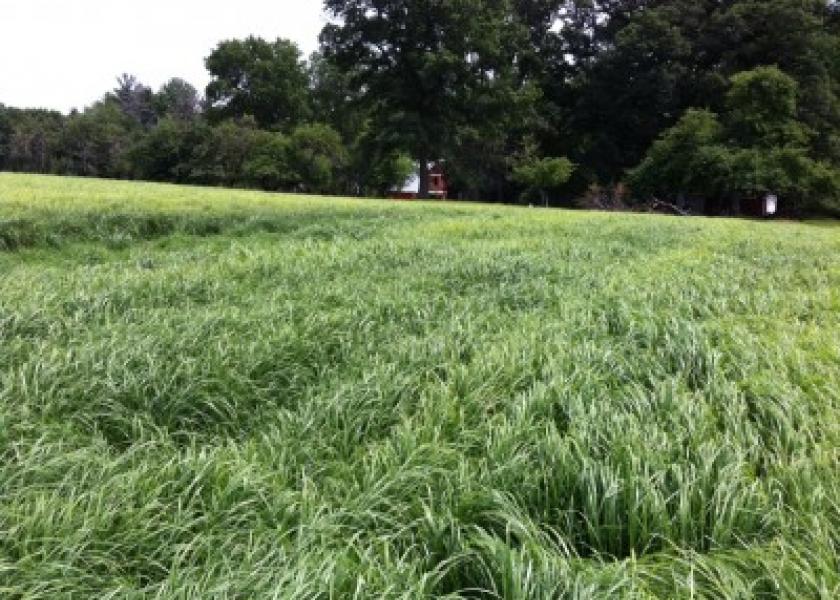Teff Grass is Working in Hay Crop Rotations

Teff Grass is gaining in popularity as an alternative forage crop in Michigan.
By: Jerry Lindquist, Michigan State University Extension
Teff, Eragrostis tef Zucc., is a warm season annual grass that is native to Ethiopia and is grown commonly in many African countries as a cereal grain for human consumption. It grows in frost free environments preferring temperatures from 60 – 85 degrees Fahrenheit and tolerates soil moisture levels ranging from moist to drought-stressed conditions.
In recent years researchers in the U.S. have discovered that Teff Grass makes a good one year hay crop. It’s rapid re-growth after cutting can provide two to three harvests in a summer even though it is commonly not planted until June.
Teff is finding favor on many Midwest hay producing farms for two main reasons. First, animals including cattle and horses really like it, and secondly, it works well in hay crop rotations. Michigan State University Extension does not recommend planting alfalfa after alfalfa because of disease, insect and autotoxicity issues. Autotoxicity, which is produced by mature alfalfa plants, will cause crop stunting and yield reduction of the new plants. Rotation to another crop is always advised at least for one year and Teff – which is a grass and not in the alfalfa legume family – can fit that bill.
Farms can always rotate to other grain crops like corn, wheat or soybeans, but not everyone has equipment to plant and harvest cash crop grains. With Teff the same planting equipment as well as the same hay mowing and baling equipment that you use for other hay crops can be used. It also means the farm’s rotation acres never have to be out of hay production if they so desire.
The feed quality of Teff is moderate, not as high as a pure alfalfa hay crop, but generally, if cut at the pre-boot stage of growth, higher than most cool season grasses. You can attain crude protein levels of 12 – 16 percent C.P. depending upon maturity at harvest and if the crop was fertilized with nitrogen. It meets the nutritional needs of the light working horse, the dry cow and if supplemented with grain, the growing replacement heifer. Horse owners feel their horses stay healthier and maintain the proper stage of body condition when fed Teff Grass hay.
Research trials at Michigan State University and other land grant universities reveal that Teff varieties can yield 3 – 5 tons of dry matter hay per acre. Northern zones may only get two cuttings and yields will be closer to 3 tons per acre, but southern parts of Michigan and beyond can attain three cuttings and over 5 tons per acre of hay is possible in good years.
The seed is small, 1.25 million seeds per pound, so planting into level, firm seed beds is strongly advised. Planting approximately 8 - 10 lbs. of seed per acre is the recommended rate and it should not be sown until the risk of spring frost is gone. If wet, cool spring conditions prevail, waiting for soil warm-up is advised as planting in Mid-June in trials yielded the best at the MSU Campus.
Like all new hay seedings, weeds can be a problem in the first cutting of Teff grass. If a grass herbicide was used to eliminate the previous sod hay crop, the only weed issue that will normally appear in the first cutting will be broadleaf weeds and they can be easily controlled with timely applications of inexpensive broadleaf weed herbicides.
Soil testing and fertilizing to meet the nutritional needs of Teff grass is important, especially making sure it has adequate nitrogen. If a previous hay crop had at least 30 percent legumes in it, there may be enough residual nitrogen to grow Teff well, but if not, it is advised to apply 60 – 80 lbs. per acre of actual nitrogen at planting time.
Teff Grass has a finer stem than most cool season grasses, even finer than many alfalfa varieties. Because of this it will lay more tightly in a windrow and not dry as rapidly as some other hays. With good drying conditions it is not a problem, but at the end of the summer season, or in periods without much sunshine or wind, it can be a challenging crop to dry. Laying a wide swath at mowing time, conditioning the stem and even using a tedder may be necessary to get it to dry properly for baling.
When taking on new acres that have been idle for some time, Teff makes a good first choice for a hay crop. Weeds are usually an issue and soil pH may require some lime so Teff Grass is the better first choice for a hay crop to get the weeds and soil fertility in order before planting a perennial hay crop. Planting Teff even for two years in a row may be beneficial and make for a better, long lasting alfalfa hay crop.
There are many choices for a rotation crop following alfalfa/grass hay crops. Teff grass is the newer alternative that has some unique attributes which may make it a good choice when buying seed this winter.







